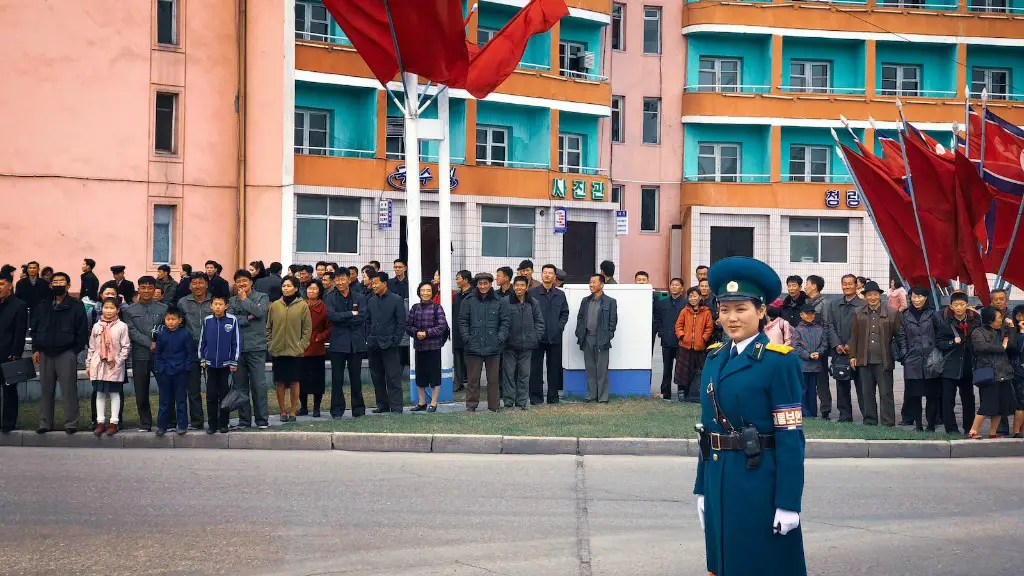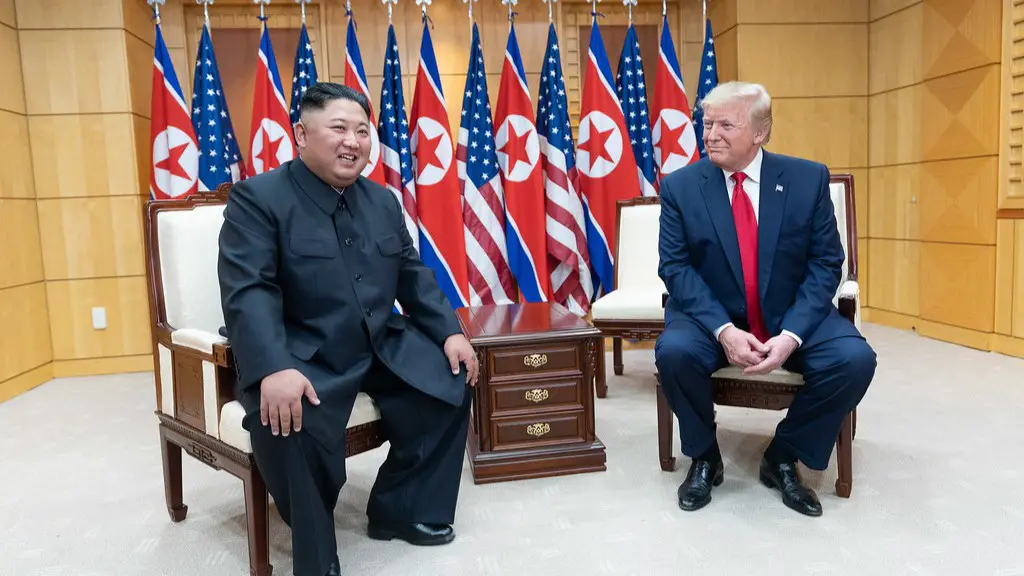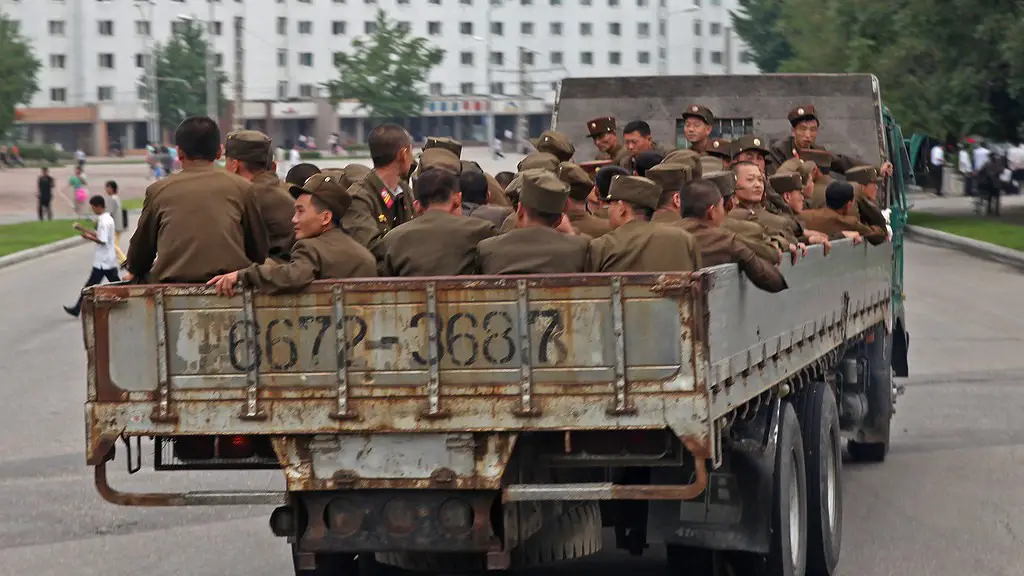Introduction
North Korea is the world’s most reclusive state, and its armed forces are a mystery to many outside observers. To understand the power and composition of North Korea’s military, it is important to know how many armies it has and how it is organized. This article will explain the organization of North Korea’s army, break down its estimated troop strength, and provide insight into how the North Korean military operates.
Size and Structure of North Korea’s Army
North Korea’s army is the largest branch of its military and is composed of almost 1.2 million active personnel. This number is even more impressive when taking into account the fact that North Korea’s population is only 25 million people. This means that more than 5% of its population is tied up in military service, the highest in the world. Moreover, the country has in place a compulsory military service law, which states that all males must serve a minimum of 10 years in the armed forces.
The North Korean army is divided into the People’s Army, which is the land-based component, and the Naval Force, which is the naval component. Within the People’s Army are five branches: Infantry, Armor, Special Operations, Artillery, and Air Defense. All of these branches have their own corps and regiments, and each regiment can have anywhere from 2,000 to 8,000 personnel. Furthermore, the North Korean army is backed up by an extensive system of reserve forces, which can be called up in times of emergency. It is estimated that North Korea has over 5 million reservists.
Weapons and Equipment
North Korea has a large arsenal of weapons and equipment at its disposal. It is estimated that the North Korean army has almost 17,000 tanks and armored vehicles, most of which are Soviet-made models from the 1950s and 1960s. The army is also equipped with more than 8,000 howitzers and 2,000 multiple rocket launchers. In addition, the North Korean air force has an estimated 1,300 aircraft, including several hundred fighter jets.
The North Korean government also makes extensive use of guerilla tactics. The military employs a wide range of small arms, including rifles, submachine guns, and handguns. These are backed up by an array of man-portable anti-tank weapons such as rocket-propelled grenades and other explosives.
Cyberwarfare Capabilities
In recent years, North Korea has become a major player in the field of cyberwarfare. The country has a powerful and sophisticated cyberwarfare force that is capable of launching sophisticated cyberattacks against its enemies. This force consists of a network of hackers and computer experts that have been trained in the most up-to-date techniques of cyberwarfare. Some of the most famous cyberattacks attributed to North Korea have been the WannaCry virus, the Sony Pictures hack, and the 2016 Bangladesh Bank theft.
Research and Development
North Korea has also invested heavily in research and development, particularly in the field of military hardware. For example, the country is known to possess advanced ballistic missiles and chemical weapons. It is also believed to have a nuclear weapons program, although the extent of this program is still unknown. Much of this research and development is undertaken by North Korea’s Ministry of People’s Armed Forces and the General Political Bureau.
Strategy and Training
North Korea’s strategy is largely focused on defense. This is evidenced by the country’s large number of defensive installations and fortifications, as well as its extensive network of tunnels and underground bunkers. North Korea also intensely trains its troops, although the exact extent of this training is unknown. However, it is believed that North Korean troops are well trained in conventional combat tactics, as well as guerilla warfare and the use of unconventional weaponry.
Economic Impact of North Korea’s Army
North Korea’s extensive military forces have a huge economic impact on the country. The army consumes a large portion of North Korea’s budget, estimated to be around one-third of the total budget. This is a massive percentage, especially when considering the fact that North Korea’s economy is still largely centrally planned. This has led to severe budget deficits and an increasing reliance on foreign aid.
The size and power of North Korea’s military also plays a role in foreign policy. North Korea is extremely confrontational, and the size and power of its military allows it to project strength in the region. This often leads to an arms race with neighboring countries, and to increased tensions with the United States and other Western nations.
North Korea’s Nuclear Arsenal
North Korea is believed to possess a substantial nuclear arsenal, although the size and composition of this arsenal is unknown. The country is known to possess a number of intermediate range and intercontinental range ballistic missiles, as well as a number of miniaturized nuclear warheads. These are believed to be stored in underground complexes and designed to be deployed at short notice.
North Korea has also openly stated its desire to use its nuclear weapons in the event of a conflict, and the country routinely threatens its enemies with nuclear force. This increases tensions in the region and has led to a series of international sanctions aimed at forcing North Korea to give up its nuclear weapons.
The Role of China
The role of China in North Korea’s army is an important one. China provides the North Korean military with a significant amount of logistical and financial support. This includes arms sales, military training, and economic aid. This support has been instrumental in allowing North Korea to maintain such a large and powerful military.
In addition, China has long sought to act as a buffer between North Korea and the West, as it is one of the few countries that still has significant influence over the country. This has included attempts to defuse tensions or broker negotiations between the North Korean leadership and the international community.
Public Perception of North Korea’s Army
The public perception of North Korea’s army is largely negative. Due to the country’s oppressive regime and its belligerence towards other countries, the army is seen by many as a force of tyranny and aggression. This perception is reinforced by reports of human rights abuses and war crimes committed by North Korean soldiers.
In addition, many of North Korea’s citizens are conscripted into the military, and there are numerous reports of mistreatment of these conscripts. This further increases the public’s negative perception of the North Korean army.
Conclusion
The North Korean army is the largest branch of its military, with almost 1.2 million active personnel. The army has a large arsenal of weapons and equipment, as well as a sophisticated cyberwarfare force and a nuclear weapons program. It is also heavily supported by China, and its size and power is a source of tension in the region. However, the public perception of North Korea’s army is largely negative due to the oppressive nature of the country’s government and its reported war crimes.


